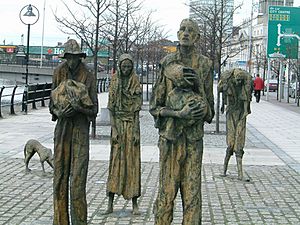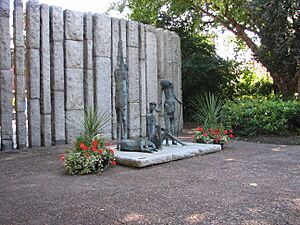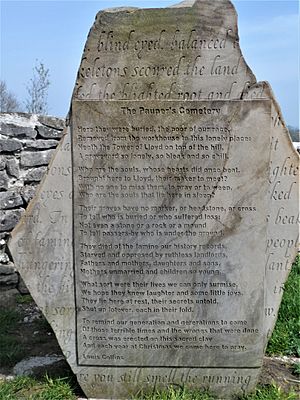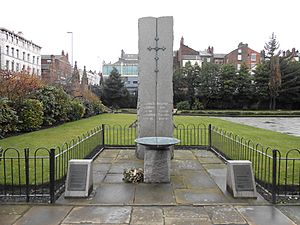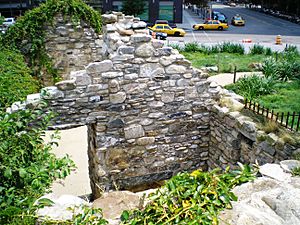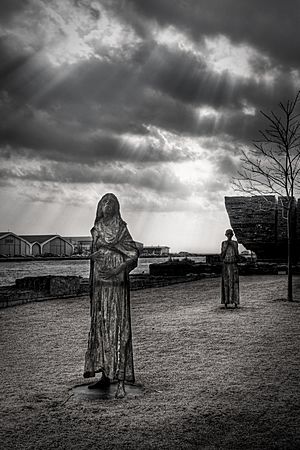List of memorials to the Great Famine facts for kids
The Great Famine was a terrible time in Ireland between 1845 and 1852. A plant disease destroyed the potato crop, which was the main food for many people. This led to widespread hunger, sickness, and death. Many people also had to leave Ireland to find food and a better life elsewhere.
Today, there are over 100 memorials around the world that help us remember the Great Famine. These memorials are found in Ireland and in other countries where Irish people settled after leaving their homeland. They help us understand the suffering of those times and honor the people who were lost or forced to emigrate. You can find out more about these memorials here: [1].
Contents
Remembering the Great Famine in Ireland

Many memorials are found across Ireland, especially in areas that suffered the most during the Famine.
County Clare
- Ennistymon: This was the first memorial in Ireland to honor those who suffered. It is near the local workhouse, where many people died. A mass grave for children who died without coffins is also here.
- Tuamgraney: A famine graveyard memorial is located at St. Cronan's Church, Tuamgraney.
County Cork
- Midleton: Here you can find the unique Kindred Spirits sculpture.
County Donegal
- Doagh Island, Inishowen: The Doagh Visitor Centre and Famine Museum shows how the Famine affected this area.
County Dublin
- Customs House Quays: The Famine Memorial (Dublin) features very thin statues by artist Rowan Gillespie. They look like people walking towards ships to leave Ireland.
- St Stephen's Green, Dublin: "Famine" is a sculpture by Edward Delaney.
County Galway
- Ballinasloe: The Famine Remembrance Park is in Cleaghmore.
- Galway: The Galway Famine Ship Memorial is in Celia Griffin Memorial Park, Salthill.
County Limerick
- Kilmallock: A Famine Memorial Park marks the graves of those who died in the nearby workhouse and were buried without names.
- Limerick city: The 'Broken Heart' Famine memorial by Maria Pizzuti is a fountain shaped like a broken heart. It remembers the thousands who were forced to leave for America. Also, in the Pauper's Graveyard (now St Brigid's cemetery) in Killeely, a large wooden cross marks a mass grave.
- Newcastle West: The Famine Graveyard is behind St. Ita's Hospital. Hundreds of Famine victims are buried here in unmarked graves. A simple old cross marks the cemetery.
County Kilkenny
- Kilkenny: A small garden memorial is in the McDonagh Junction complex. Many bodies were found here during building work.
County Laois
- Donaghmore: The Famine Museum is located in the old Donaghmore Workhouse.
County Mayo
- Doo Lough: A memorial remembers victims of the Doolough Tragedy. Many people died here after walking a long distance to ask for help but were refused.
- Murrisk: The National Famine Memorial is a sculpture of a famine ship by John Behan. It shows the refugees as very thin, almost like skeletons, in the ship's ropes.
County Meath
- Kells, County Meath: A memorial for the paupers' graveyard is by the Spire of Lloyd.
County Monaghan
- Clones: This town has a Famine Graveyard. In 2011, Clones hosted the National Famine Commemoration, with President Mary McAleese attending.
County Roscommon
- The National Famine Museum is located at Strokestown Park.
County Sligo
- Sligo: Three sculptures remember the Famine. One is at the quayside, showing a family comforting each other. About 30,000 people left from here between 1847 and 1851. The other two are at a famine graveyard, marking its gates and a tree called Faoin Sceach. About 2,000 Famine victims are buried here.
County Tipperary
- Ballingarry: The Famine Warhouse 1848 is now a museum. It was the site of a rebellion in 1848.
- Thurles: The Famine Museum is in St. Mary's church. This site has memorials for both war and the Irish Famine.
County Westmeath
- Mullingar: The Famine Memorial Fountain stands on Oliver Plunkett Street.
County Wicklow
- Ballyhogue Famine Wall, Ballyhogue, Bree.
Famine Memorials in the United Kingdom

Many Irish people went to the United Kingdom to escape the Famine.
- Liverpool, England: A memorial is in the grounds of St Luke's Church. It reminds us that over 1.2 million Irish immigrants arrived in Liverpool between 1849 and 1852. Many then traveled to other parts of the world. About 7,000 people died in Liverpool in one year. Ten plaques around the city also mark the Famine. One at Clarence Dock says: "Through these gates passed most of the 1,300,000 Irish migrants who fled from the Great Famine and 'took the ship' to Liverpool in the years 1845–52." The Maritime Museum in Albert Dock also has an exhibition about Irish migration.
- Cardiff, Wales: A Celtic Cross made of Irish stone stands in Cathays Cemetery. It was put up in 1999 to remember the 150th anniversary of the Famine. It honors all people of Irish origin who died in Wales.
- Carfin, Motherwell, North Lanarkshire: A Celtic Cross memorial was unveiled by the Irish Prime Minister, Bertie Ahern, in the early 2000s.
- Glasgow: A memorial to the Irish and Highland famines was unveiled in Glasgow in 2018. It is located near the People's Palace at Glasgow Green. The football club Celtic FC sometimes wears a special emblem to remember the Famine. This is because Celtic was founded by Irish immigrants in Glasgow.
- Craigavon, Northern Ireland: A tree sculpture at Tannaghmore Gardens remembers the Famine.
Famine Memorials in the United States
Many Irish people traveled to the United States during and after the Famine.
- Boston, Massachusetts: The Boston Irish Famine Memorial has bronze statues. One shows a starving woman with her children, looking up. Another shows hopeful figures arriving in Boston.
- Buffalo, New York: A stone memorial stands on its waterfront.
- Cambridge, Massachusetts: The Irish Famine Memorial is located at Cambridge Common.
- Chicago, Illinois: There is a Famine Memorial at Chicago Gaelic Park.
- Cleveland, Ohio: A 12-foot-high stone Celtic cross is in Heritage Park.
- Fairfield, Connecticut: A memorial to Famine victims is in the chapel of Fairfield University.
- Hackensack, New Jersey: A large stone monument honors those who died in the Famine. Irish-American groups hold a ceremony here every October.
- Hamden, Connecticut: A collection of art and literature about the Great Famine is at Quinnipiac University.
- Irish Hills, Michigan: The An Gorta Mor Memorial is at St. Joseph's Shrine. It has 32 black stones, one for each county in Ireland.
- Keansburg, NJ: There is a Hunger Memorial in Friendship Park.
- New Orleans, Louisiana: A plaque remembers the Great Famine on the monument for the New Basin Canal.
- New York, New York: The Irish Hunger Memorial is in Battery Park City. It looks like a sloping hillside with a roofless cabin. Another memorial is in V.E. Macy Park in Ardsley, New York.
- Philadelphia, Pennsylvania: The National Memorial to An Gorta Mór is a large bronze sculpture by Glenna Goodacre. It shows the misery of starvation in Ireland. It was dedicated in 2003.
- Phoenix, Arizona: A memorial shaped like a dolmen is at the Irish Cultural Center.
- Portland, Oregon: The Oregon Irish Famine Memorial is a 14-foot-tall Celtic cross carved in Ireland. It was unveiled in 2008, with Irish President Mary McAleese present.
- Providence, Rhode Island: An Irish Famine Memorial is along the Riverway. It has a bronze statue of three Irish figures and a wall telling the Famine story. It was dedicated in 2007.
- Rochester, New York: A black granite memorial is at St. John Fisher College. It was put up in 1997. It has a moving message and the names of families who helped fund it.
- Staten Island, New York:
* 26 Central Avenue: The Marine Hospital—Quarantine Station Cemetery operated during the Famine years. Thousands of Irish immigrants died here and were buried. * 915 Victory Blvd: This Marine Hospital—Quarantine Cemetery is now a public golf course. A marker remembers the many Irish immigrants buried here. * 1562 Richmond Terrace: The Staten Island Cemetery is for children under two years old from a temporary Irish town that grew near the quarantine station.
Famine Memorials in Canada
Canada was another important destination for Irish immigrants.
- Grosse-Île, Quebec, Canada: This is the largest Famine grave site outside Ireland. A large Celtic cross overlooks the St. Lawrence River. It is a Canadian national historic site.
- Quebec City, Quebec, Canada: A 12-foot limestone cross was given by the government of Ireland in 1997.
- Saint John, New Brunswick, Canada: A large Celtic cross was built on Partridge Island, a major quarantine station during the Famine.
- Saint Andrews, New Brunswick, Canada: A Celtic cross was put up on the mainland, facing Hospital Island, which was a quarantine station.
- Kingston, Ontario, Canada: There are three monuments. A Celtic cross is at An Gorta Mor Park. Another is at Skeleton (McBurney) Park. The Angel of Resurrection monument is at St. Mary's cemetery.
- Maidstone, Ontario, Canada: A nine-foot stone Celtic Cross is at the cemetery outside St. Mary's Church.
- Montreal, Quebec, Canada: The "Black Rock" or "Stone" in Pointe-Saint-Charles was the first monument to those who died in the Great Famine. Workers building the Victoria Bridge found mass graves and put up this stone in 1859. It says: "To Preserve from Desecration the Remains of 6000 Immigrants Who died of Ship Fever A.D. 1847-48." The Montreal Irish community walks to the Stone every year to remember the dead.
- Toronto, Ontario: Four bronze statues at Ireland Park show people arriving at the Toronto wharves. There is also a list of names of those who died of typhus in Toronto. A statue outside St. Paul's Catholic Basilica remembers the Famine victims and Bishop Michael Power, who helped the sick.
Famine Memorials in Australia
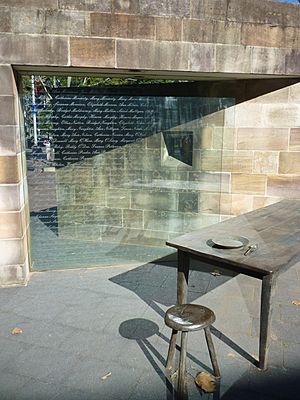
Many Irish people, including young women, also traveled to Australia.
- Melbourne, Victoria: In 1998, a memorial called the Famine Rock was put up at Williamstown. This was 150 years after the first Irish Famine orphan girls arrived. In 2013, a marker was added to tell the story of the six ships that brought about 1,700 teenage girls to Williamstown. The Famine Rock plaque has a Gaelic message: "God never meant this to happen, that people should wander hungry in the cold."
- Sydney, New South Wales: The Australian Monument to the Great Irish Famine is at the Hyde Park Barracks, Sydney. It remembers the young Irishwomen who fled the Famine. It was sculpted by Angela and Hossein Valamanesh and unveiled in 1999. It has 420 names etched into glass, a potato-digging spade, and potatoes on a shelf.
See also



